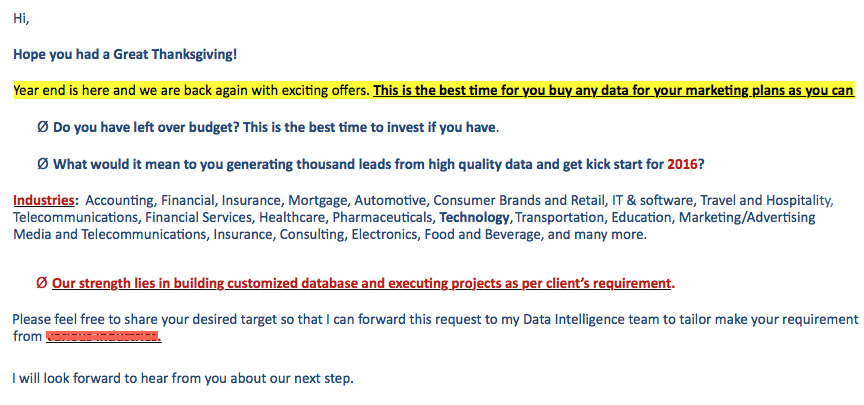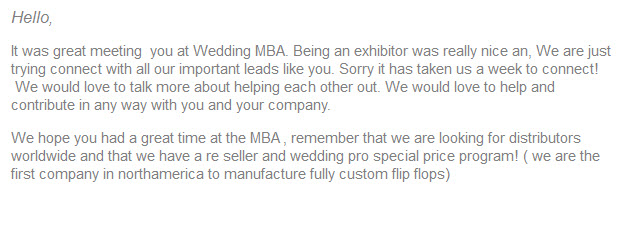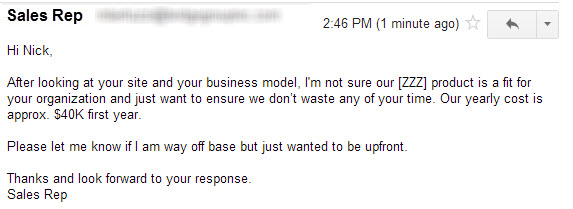There’s a lot of talk about welcome emails that set the tone for a relationship, and promotional emails that can increase sales, but follow-up sales emails are often overlooked.
Follow-up sales emails shouldn’t be treated as the black sheep of the email family. They’re an extremely vital part of your sales strategy, which can results in increased sales.
However, a lot of businesses struggle to craft a follow-up email that closes the deal. The email must be sent at the right time, the wording has to be right and it has to be powerful enough to encourage the contact to respond.
It’s not hard to find examples of poorly executed follow-up sales emails. We’ll show you three examples of horrific emails, explain what’s wrong with them and provide a solution. We’ll also provide a list of tips to ensure your follow-up emails are productive, not horrific.
Example #1: Bad email copy
A follow up email should be personalized AND specific to one person. You already made a connection with this person, now you’re looking to build on that. One of the worst things you can do is create sloppy email copy that treats your new sales lead like “one of the pack.”
Take a look at the email example below:
For starters, the email salutation just says “Hello.” It should have the person’s first name as well. Again, you want a personal touch here.
Now read the second sentence. “Being an exhibitor was a really nice an,” – that’s not a complete sentence. That’s a huge mistake. It speaks to your lack of professionalism and reflects badly on your company.
Okay, on to the next sentence. “We are just trying to connect with all our important leads like you.” This is the “pack mentality” we were warning about earlier. You don’t want to lump all of your potential leads together. Instead, make them feel special. Talk about your interaction at the event and explain why you believe a partnership will be mutually beneficial.
Now read the third sentence. “Sorry it’s taken us so long to connect!” Apologizing to a new contact this early in the relationship is not a good sign. What kind of attention will this client get if they work with your company? Will they be forgotten for a week and only dealt with when it’s convenient for you?
The remaining section of the email is riddled with grammatical and punctuation errors, which, again, reflects badly on the business.
Solution: The solution to this problem is twofold. For starters, you should personalize your emails. That means including first names, company names and maybe an anecdote about how your met or a reminder of the conversation you had.
Don’t say you’re following up with a bunch of people. Make this person feel as though they were the most important contact you met.
If you’re using automation tools, make sure first names and company names are included in the email properly. The last thing you want to do is send and email that says Hello [FName].
The second part of the solution is to proof read your email. Make sure you have complete sentences, run spell check and have a co-worker or a friend read the email before you send it.
Example #2: Distracting use of colors and fonts
In an effort to make a follow-up email standout, some people resort to bad email practices. We understand that you want to grab attention, but filling your email with a variety of fonts, typefaces and colors isn’t the way to go.
Take a look at the example below:

Without reading one word of text, the reader is already overwhelmed. There’s bold blue text, followed by highlighted text. There are wingdings that are supposed to simulate bullet points, random words are in red and some text is underlined.
While this email’s creator tried to create something that would standout, the sad truth is – there’s so much going on that nothing stands out.
Solution: Stick to the basics. Your email should have a clean, consistent look. Avoid using multiple fonts and a bunch of colors to attract attention. If you want to put a few key statements in bold, that’s fine. Don’t go overboard though. You want potential clients to see you as a professional company.
Example #3: Making assumptions
No one wants to waste time on a leads that are not right for their business, but you should be careful about making assumptions. Take a look at the email below:
This sales rep looked at a company’s website and business model, and basically said your company can’t afford our services. Then the sales rep tries to save face by encouraging the prospect to follow up if the assumption is “off base.” Now, if you were on the receiving end of this email and sales rep is indeed off base, would you reach out to them? Highly unlikely.
You should never send emails that make assumptions about a company, especially based on five minutes of internet research.
Solution: Send a follow up email that sets up a phone call. During that call, talk with the potential client about your product and the components needed for success. Of course, you’ll bring up the price point in the conversation too.
The phone call could confirm your suspicion that the business isn’t fit for your product or service, but that’s something you should confirm on the phone without making assumption.
Plus, you don’t know what kind of growth that business will go through in the next few months. Down the road, it could be a viable customer, but only if you made attempts to nurture the lead to begin with.
If you write the prospect off from the start, you’ve lost the business forever.
Now that we’ve shown you what not to do, let’s talk about what you should do.
Tips to create effective follow-up sales emails:
- Send the follow-up email within 48 hours
People have a short attention span, so you should send a follow-up email as soon as possible. For starters, sending immediate emails shows your interest level and dedication to your work.
If you wait too long, people forget who you are and what you talked about.
The rule of thumb is not to exceed 48 hours, but if you can send it sooner, do so.
- Remind the contact how you met
Provide some context. Briefly explain how you met. Mention the conference by name, or refer to an earlier phone call. Just a few words will do.
- Have a goal in mind
What do you want this lead to do? Do you want to initiate a sales call, set up a demonstration? Have a goal in mind before you write the email, and make sure the goal is clearly defined in the text. Express your goal as a call to action.
- Craft a subject line
Create a subject line that’s relevant and triggers the memory of a previous meeting or discussion. Here’s an example, “Great meeting you at ABC Conference, let’s connect.” Spend some time on this, as subject lines can make or break your email.
- Use tools to spot copy mistakes
We mentioned before that you should proof read your email, but there are some handy tools online that can help. Tools like Grammarly and Hemmingway Editor can spot mistakes before you hit send.
- Be persistent, but not a bother
Most small businesses send one follow-up email. If the email goes unanswered, they move to the next. But here’s an interesting statistic: 80 percent of sales require five follow-ups.
For some businesses, five follow-up emails are too much. However, the point is that it’s okay to send more than one. Don’t give up too early in the process.
With this handy guide, you’ll be on your way to creating follow-up emails that connect with your contacts and land sales.








